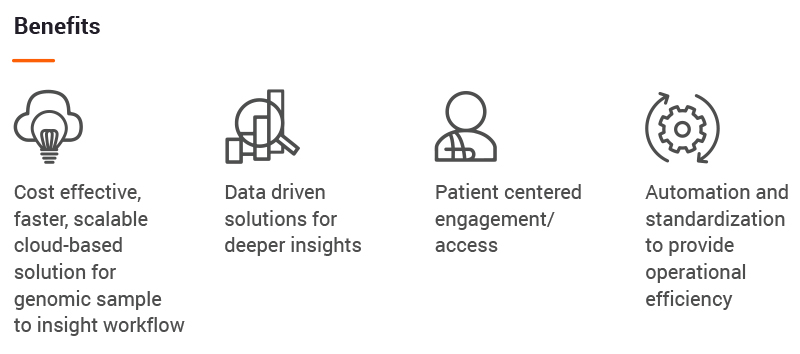With data being the new oil, genomics too has seen an exponential increase in terms of the acquisition, storage, distribution, and analysis of large datasets of human genome sequences. The current genomics data management and analysis applications fail to handle the herculean task as these applications were designed for much lower volumes of data. Therefore, there is a need to upgrade or replace the existing genomics data analysis systems. To achieve this, cloud technology is emerging as a simple, secure, and cost-effective way to store, analyze, and share the genomic data.
Genomics data analysis challenges
Clinical diagnostics labs are facing a common set of challenges while analyzing clinical genomics data
Six strategies for overcoming these challenges
Cloud computing can transform the existing small or on-premise genomics data analysis systems to efficient genomics data analysis systems. We have identified six key transformations that are helpful in scaling clinical genomics data analysis using cloud technology.
1. Scalability
Many diagnostics labs have inhouse systems designed for small volumes of genomics data analysis. They are facing hurdles in deploying or integrating new workflows and accessing large volumes of genomics data. Therefore, diagnostics labs need scaling in storage, computational resources, and analysis pipelines to handle the increasing volume of data.
For achieving scalability there is a demand for a long-term solution. This demand can be achieved by using the cloud. Cloud provides services such as IAAS, PAAS, SAAS, and DAAS which helps to make genomics data analysis systems more reliable. Cloud-based genomics data analysis eliminates hurdles in processing queues, storage, and computational server capacity.
2. Workflow Optimization
In-house genomics data analysis workflows at various diagnostics labs were build using old computational as well as bioinformatics tools for processing smaller volumes of data. Handling large-scale genomics data using such workflows is a challenging task. So, there is a need to construct effective, robust and efficient analysis workflows for achieving better quality, speed and runtime cost.
Workflows can be optimized by using Workflow Description Language (WDL) and Common Workflow Language (CWL), docker, workflow engines etc. Once the workflow is dockerized, we can deploy it on the cloud for getting better performance. All necessary software dependencies can be made available in the cloud container through cloud services, which makes it relatively easy to resolve software compatibility issues.
3. Reducing Turnaround Time
The performance of the system is based upon the turnaround time of sample processing. A reliable and robust system always analyzes large-scale genomics data in lesser turnaround time. To reduce the turn around time of the system there are challenges such as manual intervention, parallelism, automation, integration etc.
Challenges in reducing the turnaround time of genomics data analysis can be achieved by adopting automation and integration in the existing systems. The cloud helps to automate and integrate existing systems. Automation of the systems involves cloud-based workflows that take input from the sequencer and produces reports by integrating the sample metadata. By using the cloud, one can also process multiple samples simultaneously.
4. Security & Regulatory Compliance
To expand into new regions or countries, diagnostics company needs to be updated with regulatory compliance and security issues which include newer or varying regulatory compliance, security and industry expectations from the informatics platform point of view.
The challenge of security and regulatory compliance can be handled by an expert team with the knowledge of regulatory compliance related to technology and cloud. An IT company that has experience in the development of genomics data analysis applications using clouds can provide better service with impeccable security and regulatory compliance.
5. Managing Cost
As genomics data size is increasing, the cost for analyzing genomics data is also increasing. Hence, extra money is spent in operating, scaling, maintaining, securing and providing supports to genomics data analysis. To control this IT cost is a challenging task.
This cost can be reduced by using cloud-based genomics data analysis since we do not need to purchase software, tools, infrastructure and storage-related applications separately. Cloud services also come at a cost, but it’s based on a “pay as you go” model.
6. Operations & Support
Application development and deployment is a straightforward task but maintaining the applications after deployment is also a very important step. For building applications, we are investing time, money and human resources. For better performance, the diagnostic labs need to provide the maintenance support in operations, cloud issues, unplanned system downtime and extended turnaround times for the application.
Software maintenance and technical support is a continuous commitment for any IT company. Experts who maintain the applications should always be abreast with the latest security and compliance regulations and, software patches and technology updates. Hence, they can provide software maintenance and technical support for the applications effectively and efficiently without any hurdles.
Benefits of Genomics Data Analysis with Cloud
Persistent offers a complete solution for implementing and scaling clinical genomics data analysis using cloud computing. PSL has a team of experts with extensive domain knowledge in genomics and cloud computing. From its experience in cloud-based applications and with the help of the genomics experts, Persistent provides cloud-based solutions to various complex genomics problems by handling different challenges.








